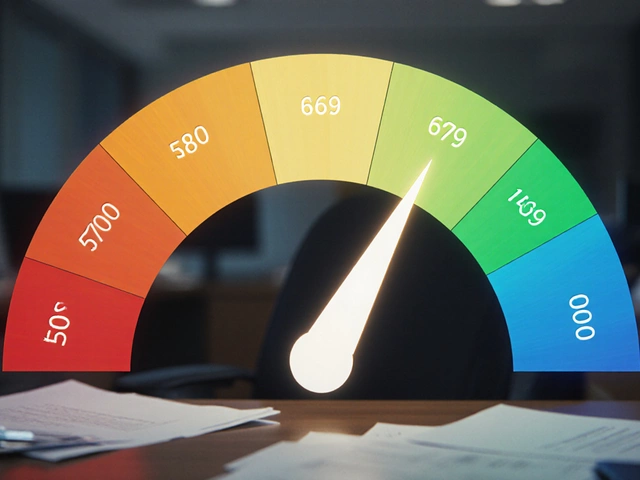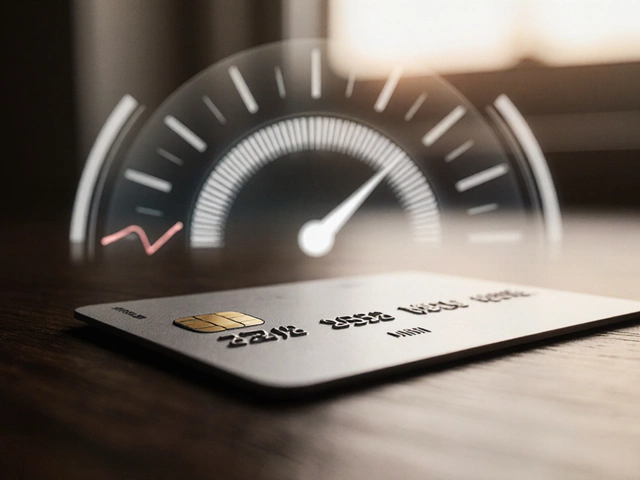
The numbers on a personal loan offer can feel like alphabet soup. APR, interest, fees—what actually matters if you just want your loan to cost less? If you're looking at borrowing money this year, don't let the jargon trip you up. Getting a good APR (Annual Percentage Rate) can save you hundreds, even thousands, over the life of your loan.
Here's the thing about APR: it's not just the interest rate. It wraps in any extra fees the lender tacks on, so you see the true yearly cost of your loan. That means a loan with a low sticker rate but high upfront fees can end up being more expensive than one with a slightly higher APR but no surprise charges. Paying attention to the APR is your shortcut for figuring out which loan actually gives you the best deal.
Rates are all over the map this year. Some people are locked in at under 7% because their credit is basically flawless, and others see offers pushing 36% (yikes). Most folks land somewhere between 11% and 24%, depending on their credit score and a few other factors lenders really care about. The good news is, with a little work, almost anyone can shave points off those offers. Want to know what changes the numbers and how to get the lowest possible APR? Keep reading—I've got answers and a few tips Larissa swears by when we’re shopping for loans.
- APR: What It Really Means
- Average APRs in 2025
- What Impacts Your Rate
- How to Snag a Lower APR
- Comparing Offers: Red Flags and Quick Wins
APR: What It Really Means
APR stands for Annual Percentage Rate, and it’s the real number you want to look at when shopping for personal loans. It tells you what you’ll pay over a year, including both the interest rate and most of the fees the lender charges. Why does this matter? Some loans look cheap at first glance, but hidden fees bump up the total cost. APR makes it easy to see the whole picture and tells you how expensive a loan really is.
You’ll see two main numbers in loan offers: the interest rate and the APR. The interest rate is just what you pay for borrowing the money. The APR adds in stuff like origination fees—basically, the cost to set up your loan—which can be anywhere from 1% to 10% of the amount you borrow. If the APR is a lot higher than the interest rate, there are probably fees included. If the numbers are close, the loan has few (if any) extra fees.
Here’s how that stacks up with an example. Let’s say you’re looking at a $10,000 loan:
| Loan | Interest Rate | Fees | APR |
|---|---|---|---|
| Lender A | 8.99% | $500 origination fee | 11.21% |
| Lender B | 10.99% | $0 | 10.99% |
It’s easy to get hooked by a low interest rate, but the APR tells you Lender A’s deal actually costs more in the end, thanks to those upfront fees. That’s why comparing only interest rates can be misleading.
- Personal loan rates are always best compared by APR, not just interest rate.
- If you see a big gap between the interest rate and APR, watch out for big fees.
- Lenders must show you the APR by law—so always ask if you don't see it.
APR makes it easier to compare apples to apples when picking a loan. It’s your shortcut for finding the offer that's actually the cheapest, not just the one that looks flashy up front.
Average APRs in 2025
The typical personal loan rates have shifted a bit in 2025, and it pays to know where you stand. Lenders now look even harder at your credit, income, and debt. So what's actually "normal" nowadays? Here’s what the numbers look like based on data from big banks, credit unions, and popular online lenders.
| Credit Score Range | Average APR (2025) |
|---|---|
| Excellent (760+) | 6.9% – 10.5% |
| Good (700-759) | 10.6% – 15.5% |
| Fair (640-699) | 15.6% – 22.9% |
| Poor (639 and below) | 23% – 36% |
As you can see, your credit score makes a massive difference. Someone with an excellent score could get a loan for less than half what someone with average credit might pay. The gap is even wider if you get stuck in the "poor" credit range—APR caps out at 36%, which is the legal limit for most personal loans.
It’s not just about the bank you pick, either. Credit unions and some online lenders tend to offer lower average rates if you have decent credit. Here’s the kicker: some online-only lenders are moving fast on approvals, but double-check for hidden fees packed into their APRs.
To put it in perspective: If you borrow $10,000 for three years, even a 5% higher APR could cost you more than $800 over the life of that loan. So, it pays to shop around and know not just what’s average, but what you can realistically qualify for and negotiate. Always ask for a quote based on a soft credit pull—this won’t hurt your credit, and it helps you compare offers without surprises.

What Impacts Your Rate
Wondering why your buddy got a much lower APR than you did? It all comes down to how lenders size you up. Even if two people ask for the same amount of money, their rates can be totally different. Here’s what makes the biggest difference:
- Credit Score: This is the big one. The higher your credit score, the lower your personal loan rates. For most lenders, 720 or higher is considered excellent. If you’re below 640, expect to see much steeper APR offers.
- Income and Debt: Lenders want to know you’ll have no trouble paying them back. So they check your income and how much debt you’re already handling. If you have a steady income and not a ton of debt, you’re seen as a safer bet (better rates!).
- Employment History: Been bouncing between jobs? That can work against you. Lenders love stable work history because it tells them your paycheck isn’t at risk of vanishing overnight.
- Loan Amount and Term: Asking for a huge loan or a more extended repayment term can sometimes mean higher rates. Lenders take on more risk with bigger loans and longer payoff periods.
- Type of Lender: Online lenders, credit unions, and banks usually offer different APR ranges. Credit unions often come in cheapest, especially if you’re a member with history. Online lenders are fast but sometimes cost more if your credit isn’t great.
One thing folks forget: lenders may not use the same formulas. One online lender might care more about your monthly rent, while a local credit union may pay close attention to your savings habits. That’s why it’s always smart to shop around instead of jumping at the first offer.
And if you’ve got a cosigner with rock-solid credit? That can help you land a lower rate. Just make sure your cosigner understands they’re on the hook if you flake on payments.
How to Snag a Lower APR
If you want to stop overpaying on personal loans, you’ve got to play the APR game smart. Lenders decide your rate based on a few things, but some you can actually control within a few months. Here’s what works if you really want to get that number down:
- Improve your credit score. This is the single biggest factor. Pay all your bills on time, get those credit card balances down below 30% of your limit, and don’t open new accounts unless you really need to. Some lenders offer their best rates only to people with scores above 720, but big jumps often happen once you cross 670 or 700.
- Shop around—like, really shop. Don’t just check one site and call it a day. Each lender has their own way of deciding your personal loan rates. Some banks look at job history or income more than credit, and online lenders can be surprisingly flexible. Use prequalification tools to compare offers without dinging your credit score.
- Consider a co-signer. If your credit isn’t perfect but you know someone with a solid credit record (hi, Larissa!), ask them to co-sign. Lenders see shared responsibility as less risk, which can drop your APR a few points.
- Try a secured loan. Not every personal loan lets you put up collateral like a car or savings account, but doing so usually means a lower APR. Just remember, if you can’t pay, you could lose that asset, so only choose this if you’re sure you can handle the payments.
- Borrow only what you need. Requesting a lower amount often results in better rates. Big loans can signal higher risk, and some lenders reward requests that seem reasonable for your income and credit profile.
One of the sneakiest tricks? Paying off some existing debt (especially credit cards) and then reapplying. Lenders check your debt-to-income ratio at the time you apply, so even a $1,000 drop can bump you into a better rate category within weeks. If you want the cheapest APR, time your application for when your credit and your paychecks look their best. It’s a simple move most people overlook, but it works.
Finally, don’t be shy about asking lenders directly if they’ll match a better offer. Lots of places will negotiate, especially if you’ve got a strong application. You’d be surprised how often a quick phone call can save you serious cash over the life of your loan.

Comparing Offers: Red Flags and Quick Wins
So, you've got a few personal loan offers in front of you. They all use different layouts, some hide numbers in the fine print, and almost all claim they're giving you a deal. How do you know which one is the real bargain?
First, always focus on the personal loan rates—that number tells you what percentage you'll pay in interest and fees over a year. It’s the only way to compare apples to apples.
| APR (%) | Loan Amount ($) | Monthly Payment ($) | Total Cost ($) |
|---|---|---|---|
| 8.5 | 10,000 | 205 | 12,300 |
| 18.0 | 10,000 | 254 | 15,240 |
| 25.0 | 10,000 | 293 | 17,580 |
Lenders aren't shy about slipping in extra fees. Look for:
- Origination fees: Some lenders charge 1-6% of the loan just to get started. That’s money you never see.
- Prepayment penalties: A fee just for paying off your loan early? Walk away.
- Lack of transparency: If it’s hard to find the real APR or terms without digging, odds are the deal isn’t great.
- Variable rates: If your rate isn’t fixed, it could jump later—even if it starts low. In most cases, stick to fixed-rate loans.
Now, for quick wins when comparing loans:
- Use prequalification tools: Most lenders let you check rates with a soft credit pull. This won't ding your score. Shop around before you pick.
- Check bonus perks: Some lenders offer rate discounts for autopay, bundling loans, or having a checking account with them. These small perks add up.
- Calculate total costs: Don’t just look at monthly payments. That cheap payment may come with a longer term and more interest in the end.
- Trust your gut: If a lender is pushing you to decide fast or can’t answer your questions clearly, move on.
Remember, most folks in 2025 qualify for APRs between 11% and 24% for personal loans, according to the latest Federal Reserve data. If you see anything higher, or lower with weird strings attached, double-check the details. The right offer should be simple and upfront. If it feels complicated, there’s probably a catch.








Write a comment